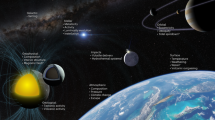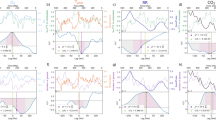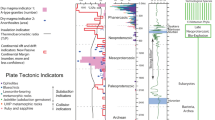Abstract
Although we have a reasonable understanding of the physical and chemical conditions required to support the growth and reproduction of organisms, we still have only a rudimentary grasp of the geophysical conditions required to sustain those conditions over geological timescales. We propose that a strengthening of the interface between geophysics and biology is required to quantify sustained habitability and ultimately to mature the science of comparative habitability. Comparative habitability will inform our understanding of the common principles that allow habitability to be sustained on different planetary bodies, and whether habitability is predictable or contingent for a given set of planetary body characteristics. These developments are enabled by missions in our Solar System, including those to icy bodies such as Europa, Enceladus and Titan, in combination with telescopes allowing us to study habitability on exoplanets, thus providing essential insights into processes that can enable sustained habitability. Comparative habitability will help to determine whether Earth is a rare outpost of conditions suitable for a multi-billion-year biosphere, or whether the conditions that allowed for sustained habitability here are common in the Universe.
This is a preview of subscription content, access via your institution
Access options
Access Nature and 54 other Nature Portfolio journals
Get Nature+, our best-value online-access subscription
$29.99 / 30 days
cancel any time
Subscribe to this journal
Receive 12 digital issues and online access to articles
$119.00 per year
only $9.92 per issue
Buy this article
- Purchase on Springer Link
- Instant access to full article PDF
Prices may be subject to local taxes which are calculated during checkout




Similar content being viewed by others
Change history
09 January 2024
A Correction to this paper has been published: https://doi.org/10.1038/s41550-024-02196-w
References
Shock, E. L. & Holland, M. E. Quantitative habitability. Astrobiology 7, 839–851 (2007).
Cockell, C. S. et al. Habitability – a review. Astrobiology 16, 89–117 (2016).
Méndez, A. et al. Habitability models for astrobiology. Astrobiology 21, 1017–1027 (2021).
Petkowski, J. J., Bains, W. & Seager, S. On the potential of silicon as a building block for life. Life 10, 84 (2020).
Chivian, D. et al. Environmental genomics reveals a single-species ecosystem deep within Earth. Science 322, 275–278 (2008).
Remick, K. A. & Helmann, J. D. The elements of life: a biocentric tour of the periodic table. Adv. Microb. Physiol. 82, 1–127 (2023).
Price, P. B. & Sowers, T. Temperature dependence of metabolic rates for microbial growth, maintenance, and survival. Proc. Natl Acad. Sci. USA 101, 4631–4636 (2004).
Cockell, C. S., Samuels, T. & Stevens, A. H. Habitability is binary, but it is used by astrobiologists to encompass continuous ecological questions. Astrobiology 21, 1017–1027 (2021).
Vance, S. D. et al. Geophysical investigations of habitability in ice-covered ocean worlds. J. Geophys Res. Planets 123, 180–205 (2018).
Meadows, V. S. et al. The habitability of Proxima Centauri b: environmental states and observational discriminants. Astrobiology 18, 133–189 (2022).
Kaltenegger, L., Lin, Z. & Rugheimer, S. Finding signs of life on transiting Earthlike planets: high-resolution transmission spectra of Earth through time around FGKM host stars. Astrophys. J. 904, 10 (2020).
Des Marais, D. J. et al. Remote sensing of planetary properties and biosignatures on extrasolar terrestrial planets. Astrobiology 2, 153–181 (2002).
Kasting, J. F., Whitmire, D. P. & Reynolds, R. T. Habitable zones around main sequence stars. Icarus 101, 108–128 (1993).
Kaltenegger, L. How to characterize habitable worlds and signs of life. Ann. Rev. Astron Astrophys. 55, 433–485 (2017).
Ramirez, R. M. A more comprehensive habitable zone for finding life on other planets. Geosciences 8, 280 (2018).
Lin, Z., Macdonald, R. J., Kaltenegger, L. & Wilson, D. J. Differentiating modern and prebiotic Earth scenarios for TRAPPIST-1e: high-resolution transmission spectra and predictions for JWST. Mon. Not. R. Astron. Soc. 505, 3562–3578 (2021).
Hoehler, T. M., Bains, W., Davila, A., Parenteau, M. N. & Pohorille, A. in Planetary Astrobiology (eds Meadows, V. et al.) 37–69 (Univ. Arizona, 2020).
Beatty, J. T. et al. An obligately photosynthetic bacterial anaerobe from a deep-sea hydrothermal vent. Proc. Natl Acad. Sci. USA 102, 9306–9310 (2005).
Kminek, G. et al. Report of the COSPAR Mars Special Regions Colloquium. Adv. Space Res. 46, 811–829 (2010).
Takai, K. et al. Cell proliferation at 122 °C and isotopically heavy CH4 production by a hyperthermophilic methanogen under high-pressure cultivation. Proc. Natl Acad. Sci. USA 105, 10949–10954 (2008).
Cockell, C. S., Wordsworth, R., Whiteford, N. & Higgins, P. M. Minimal units of habitability and their abundance in the universe. Astrobiology 21, 481–489 (2021).
Suttle, M. D., King, A. J., Schofield, P. F., Bates, H. & Russell, S. S. The aqueous alteration of CM chondrites, a review. Geochim. Cosmochim. Acta 299, 219–256 (2021).
Schulze-Makuch, D. & Crawford, I. A. Was there an early habitability window for Earth’s moon? Astrobiology 18, 985–988 (2018).
Grotzinger, J. P. et al. A habitable fluvio-lacustrine environment at Yellowknife Bay, Gale Crater, Mars. Science 343, 1242777 (2014).
Stoker, C. et al. Habitability of the Phoenix landing site. J. Geophys. Res. 115, E00E20 (2010).
Hurowitz, J. A. et al. Redox stratification of an ancient lake in Gale crater, Mars. Science 356, eaah6849 (2017).
Parkinson, C. D., Liang, M.-C., Yung, Y. L. & Kirschvink, J. L. Habitability of Enceladus:planetary conditions for life. Orig. Life Evol. Biosph. 38, 355–369 (2008).
Origins, Worlds, and Life: A Decadal Strategy for Planetary Science and Astrobiology 2023-2032 (National Academies, 2022).
Waite, J. H. et al. Liquid water on Enceladus from observations of ammonia and 40Ar in the plume. Science 460, 487–490 (2009).
Postberg, F. et al. Detection of phosphates originating from Enceladus’s ocean. Nature 618, 489–493 (2023).
Waite, J. H. et al. Cassini finds molecular hydrogen in the Enceladus plume: evidence for hydrothermal processes. Science 356, 155–159 (2017).
Taubner, R.-S. et al. Biological methane production under putative Enceladus-like conditions. Nat. Commun. 9, 748 (2018).
Affholder, A., Guyot, F., Sauterey, B., Ferrière, R. & Mazevet, S. Bayesian analysis of Enceladus’s plume data to assess methanogenesis. Nat. Astron. 5, 805–814 (2021).
Hsu, H.-W. et al. Ongoing hydrothermal activities within Enceladus. Nature 519, 207–210 (2015).
Hurford, T. A., Helfenstein, P., Hoppa, G. V., Greenberg, R. & Bills, B. G. Eruptions arising from tidally controlled periodic openings of rifts on Enceladus. Nature 447, 292–294 (2007).
Hedman, M. M. et al. An observed correlation between plume activity and tidal stresses on Enceladus. Nature 500, 182–184 (2013).
Nimmo, F., Porco, C. & Mitchell, C. Tidally modulated eruptions on Enceladus: Cassini ISS observations and models. Astron. J. 148, 46 (2014).
Postberg, F., Schmidt, J., Hillier, J., Kempf, S. & Srama, R. A salt-water reservoir as the source of a compositionally stratified plume on Enceladus. Nature 474, 620–622 (2011).
Nakajima, M. & Ingersoll, A. P. Controlled boiling on Enceladus. 1. Model of the vapor-driven jets. Icarus 272, 309–318 (2016).
Teolis, B. et al. Enceladus plume structure and time variability: comparison of Cassini observations. Astrobiology 17, 926–940 (2017).
Fifer, L. M., Catling, D. C. & Toner, J. D. Chemical fractionation modeling of plumes indicates a gas-rich, moderately alkaline Enceladus ocean. Planet. J. 3, 191 (2022).
Glein, C. R. & Waite, J. H. The carbonate geochemistry of Enceladus’ ocean. Geophys. Res. Lett. 47, e2019GL085885 (2020).
Vance, S. D., Hand, K. P. & Pappalardo, R. T. Geophysical controls of chemical disequilibria in Europa and other wet, rocky worlds. Geophys. Res. Lett. 43, 4871–4879 (2016).
Vance, S. D. et al. Hydrothermal systems in small ocean planets. Astrobiology 7, 987–1005 (2007).
German, C. R. et al. Ocean system science to inform the exploration of ocean worlds. Oceanography 35, 16–22 (2022).
Roberts, H. H. The fluffy core of Enceladus. Icarus 258, 54–66 (2015).
Choblet, G. et al. Powering prolonged hydrothermal activity inside Enceladus. Nat. Astron. 1, 841–847 (2017).
Ray, C. et al. Oxidation processes diversify the metabolic menu on Enceladus. Icarus 364, 114248 (2021).
Hand, K. P., Carlson, R. W. & Chyba, C. F. Energy, chemical disequilibrium, and geological constraints on Europa. Astrobiology 7, 1006–1022 (2007).
Kattenhorn, S. A. & Prockter, L. M. Evidence for subduction in the ice shell of Europa. Nat. Geosci. 7, 762–767 (2014).
Matsuyama, I. et al. Ocean tidal heating in icy satellites with solid shells. Icarus 312, 208–230 (2018).
Spencer, J. R. & Nimmo, F. Enceladus: an active ice world in the Saturn System. Annu. Rev. Earth Planet. Sci. 41, 693–717 (2013).
Navarro-González, R., McKay, C. P. & Mvondo, D. N. A possible nitrogen crisis for Archaean life due to reduced nitrogen fixation by lightning. Nature 412, 61–64 (2011).
Tenelanda, L. I., Parra, J. L., Cuartas-Restrepo, P. & Zuluuaga, J. I. Enceladus as a potential niche for methanogens and estimation of its biomass. Life 11, 1182 (2021).
Higgins, P. M., Glein, C. R. & Cockell, C. S. Instantaneous habitable windows in the parameter space of Enceladus’ ocean. J. Geophys. Res. 126, e2021JE006951 (2021).
van Bodegom, P. Microbial maintenance: a critical review on its quantification. Microb. Ecol. 53, 513–23 (2007).
McKenzie, S. M. et al. The Enceladus Orbilander mission concept: balancing return and resources in the search for life. Planet. Sci. J. 2, 77 (2021).
Perl, S. M. et al. A proposed geobiology-driven nomenclature for astrobiological in situ observations and sample analyses. Astrobiology 21, 954–967 (2021).
Liao, Y., Nimmo, F. & Neufeld, J. A. Heat production and tidally driven fluid flow in the permeable core of Enceladus. J. Geophys. Res. 125, e2019JE006209 (2020).
Jia, X., Kivelson, M. G., Khurana, K. K. & Kurth, W. S. Evidence of a plume on Europa from Galileo magnetic and plasma wave signatures. Nat. Astron. 2, 459–464 (2018).
McKinnon, W. B. Convective instability in Europa’s floating ice shell. Geophys. Res. Lett. 26, 951–954 (1999).
Yin, A. & Pappalardo, R. T. Gravitational spreading, bookshelf faulting, and tectonic evolution of the South Polar Terrain of Saturn’s moon Enceladus. Icarus 260, 409–439 (2015).
Barr, A. C. & Preuss, L. J. On the origin of south polar folds on Enceladus. Icarus 208, 499–503 (2010).
Howell, S. M. & Pappalardo, R. T. Can Earth-like plate tectonics occur in ocean world ice shells? Icarus 322, 69–79 (2019).
Schwieterman, E. W., Reinhard, C. T., Olson, S. L., Harman, C. E. & Lyons, T. W. A limited habitable zone for complex life. Astrophys. J. 878, 19 (2019).
Silva, L., Vladilo, G., Schulte, P. M., Murante, G. & Provenzale, A. From climate models to planetary habitability: temperature constraints for complex life. Int. J. Astrobiol. 16, 244–265 (2017).
Ballmer, M. D. & Noack, L. The diversity of exoplanets: from interior dynamics to surface expressions. Elements 17, 245–250 (2021).
Schulze-Makuch, D. et al. A two-tiered approach to assessing the habitability of exoplanets. Astrobiology 11, 1041–1052 (2011).
Rushby, A. J., Johnson, M., Mills, B. J. W., Watson, A. J. & Claire, M. W. Long-term planetary habitability and the carbonate-silicate cycle. Astrobiology 18, 469–480 (2018).
Kruijver, A., Höning, D. & van Westrenen, W. Carbon cycling and habitability of massive Earth-like exoplanets. Planet. Sci. J. 2, 208 (2021).
Kitzmann, D. et al. The unstable CO2 feedback cycle on ocean planets. Mon. Not. R. Astron. Soc. 452, 3752–3758 (2015).
Edson, A. R., Kasting, J. F., Pollard, D., Lee, S. & Bannon, P. R. The carbonate-silicate cycle and CO2/climate feedbacks on tidally locked terrestrial planets. Astrobiology 12, 562–571 (2012).
Kite, E. S. & Ford, E. B. Habitability of exoplanet waterworlds. Astrophys. J. 864, 75 (2018).
Noack, L. & Breur, D. Plate tectonics on rocky exoplanets: Influence of initial conditions and mantle rheology. Planet. Space Sci. 98, 41–49 (2014).
Stamenković, V. & Seager, S. Emerging possibilities and insuperable limitations of exogeophysics: the example of plate tectonics. Astrophys. J. 825, 78 (2016).
Ikoo, S. M. & Elkins-Tanton, L. T. The fate of water within Earth and super-Earths and implications for plate tectonics. Phil. Trans. R. Soc. A 375, 20150394 (2017).
Spiegel, D. S., Fortney, J. J. & Sotin, C. Structure of exoplanets. Proc. Natl Acad. Sci. USA 111, 12622–12677 (2014).
O’Neill, C., Lowman, J. & Wasiliev, J. The effect of galactic chemical evolution on terrestrial exoplanet composition and tectonics. Icarus 352, 114025 (2020).
Wakeford, H. R. & Dalba, P. A. The exoplanet perspective on future ice giant exploration. Phil. Trans. R. Soc. A. 378, 2020005420200054 (2020).
Raymond, C. A. et al. Impact-driven mobilization of deep crustal brines on dwarf planet Ceres. Nat. Astron. 4, 741–747 (2020).
Rothschild, L. J. The evolution of photosynthesis…again? Phil. Trans. R. Soc. B 363, 2787–2801 (2008).
Falkowski, P. G. The biological and geological contingencies for the rise of oxygen on Earth. Photosynth. Res. 107, 7–10 (2011).
Bottke, W. F. & Norman, M. D. The late heavy bombardment. Ann. Rev. Earth Planet. Sci. 45, 619–647 (2017).
Nimmo, F. & Tanaka, K. Early crustal evolution of Mars. Ann. Rev. Earth Planet. Sci. 33, 163–161 (2005).
Acknowledgements
CSC thanks the Science and Technology Facilities Council (STFC) for support under grant no. ST/V000586/1. P.M.H. acknowledges support from Natural Sciences and Engineering Research Council of Canada (NSERC) grant (No. 453949) awarded to B. Sherwood Lollar. A portion of this research was carried out at the Jet Propulsion Laboratory, California Institute of Technology, under a contract with the National Aeronautics and Space Administration (80NM0018D0004). Government sponsorship acknowledged. We thank B. Insua for work on Figs. 3 and 4. We thank F. Nimmo for helpful comments on the manuscript.
Author information
Authors and Affiliations
Contributions
The paper was conceived by C.S.C. and M.S. All authors contributed to discussions on paper content. C.S.C. drafted the manuscript and all authors contributed to editing and development of the final paper.
Corresponding author
Ethics declarations
Competing interests
The authors declare no competing interests.
Peer review
Peer review information
Nature Astronomy thanks Ramses Ramirez and the other, anonymous, reviewer(s) for their contribution to the peer review of this work.
Additional information
Publisher’s note Springer Nature remains neutral with regard to jurisdictional claims in published maps and institutional affiliations.
Rights and permissions
Springer Nature or its licensor (e.g. a society or other partner) holds exclusive rights to this article under a publishing agreement with the author(s) or other rightsholder(s); author self-archiving of the accepted manuscript version of this article is solely governed by the terms of such publishing agreement and applicable law.
About this article
Cite this article
Cockell, C.S., Simons, M., Castillo-Rogez, J. et al. Sustained and comparative habitability beyond Earth. Nat Astron 8, 30–38 (2024). https://doi.org/10.1038/s41550-023-02158-8
Received:
Accepted:
Published:
Issue Date:
DOI: https://doi.org/10.1038/s41550-023-02158-8
This article is cited by
-
The minimum energy required to build a cell
Scientific Reports (2024)



